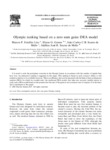Por favor, use este identificador para citar o enlazar este ítem:
http://www.alice.cnptia.embrapa.br/alice/handle/doc/17090Registro completo de metadatos
| Campo DC | Valor | Lengua/Idioma |
|---|---|---|
| dc.contributor.author | LINS, M. P. E. | pt_BR |
| dc.contributor.author | GOMS, E. G. | pt_BR |
| dc.contributor.author | MELLO, J. C. C. B. S. | pt_BR |
| dc.contributor.author | MELLO, A. J. R. S. de | pt_BR |
| dc.date.accessioned | 2014-07-31T06:53:05Z | - |
| dc.date.available | 2014-07-31T06:53:05Z | - |
| dc.date.created | 2004-05-12 | pt_BR |
| dc.date.issued | 2003 | pt_BR |
| dc.identifier.citation | European Journal of Operational Research, n. 148, p. 312-322, 2003. | pt_BR |
| dc.identifier.uri | http://www.alice.cnptia.embrapa.br/alice/handle/doc/17090 | pt_BR |
| dc.description | It is usual to rank the participant countries in the Olympic Games in accordance with the number of medals they have won. An alternative ranking is suggested in this paper. This ranking is based on each country's ability to win medals in relation to its available resources. This is an efficiency that can be measured with the help of data envelopment analysis (DEA) for which two models exist: the traditional DEA model, that takes into account variable returns to scale, and a DEA model based on the premise that the sum of the gains is zero (constant sum of outputs). It is the latter that is developed in this paper. | pt_BR |
| dc.format | folhas avulsas | pt_BR |
| dc.language.iso | eng | eng |
| dc.rights | openAccess | eng |
| dc.subject | DEA | pt_BR |
| dc.title | Olympic ranking based on a zero sum gains DEA model. | pt_BR |
| dc.type | Artigo de periódico | pt_BR |
| dc.date.updated | 2014-07-31T06:53:05Z | pt_BR |
| dc.subject.thesagro | Análise de Dados | pt_BR |
| riaa.ainfo.id | 17090 | pt_BR |
| riaa.ainfo.lastupdate | 2014-07-30 | pt_BR |
| dc.identifier.doi | 10.1016/S0377-2217(02)00687-2 | pt_BR |
| dc.contributor.institution | 1: UFRJ; 2: Embrapa Monitoramento por Satélite; 3: UFF; 4: MDF Geste and Diorama Grupo Industrial. | pt_BR |
| Aparece en las colecciones: | Artigo em periódico indexado (CNPM)  | |
Ficheros en este ítem:
| Fichero | Descripción | Tamaño | Formato | |
|---|---|---|---|---|
| 1214.pdf | 189,14 kB | Adobe PDF |  Visualizar/Abrir |









